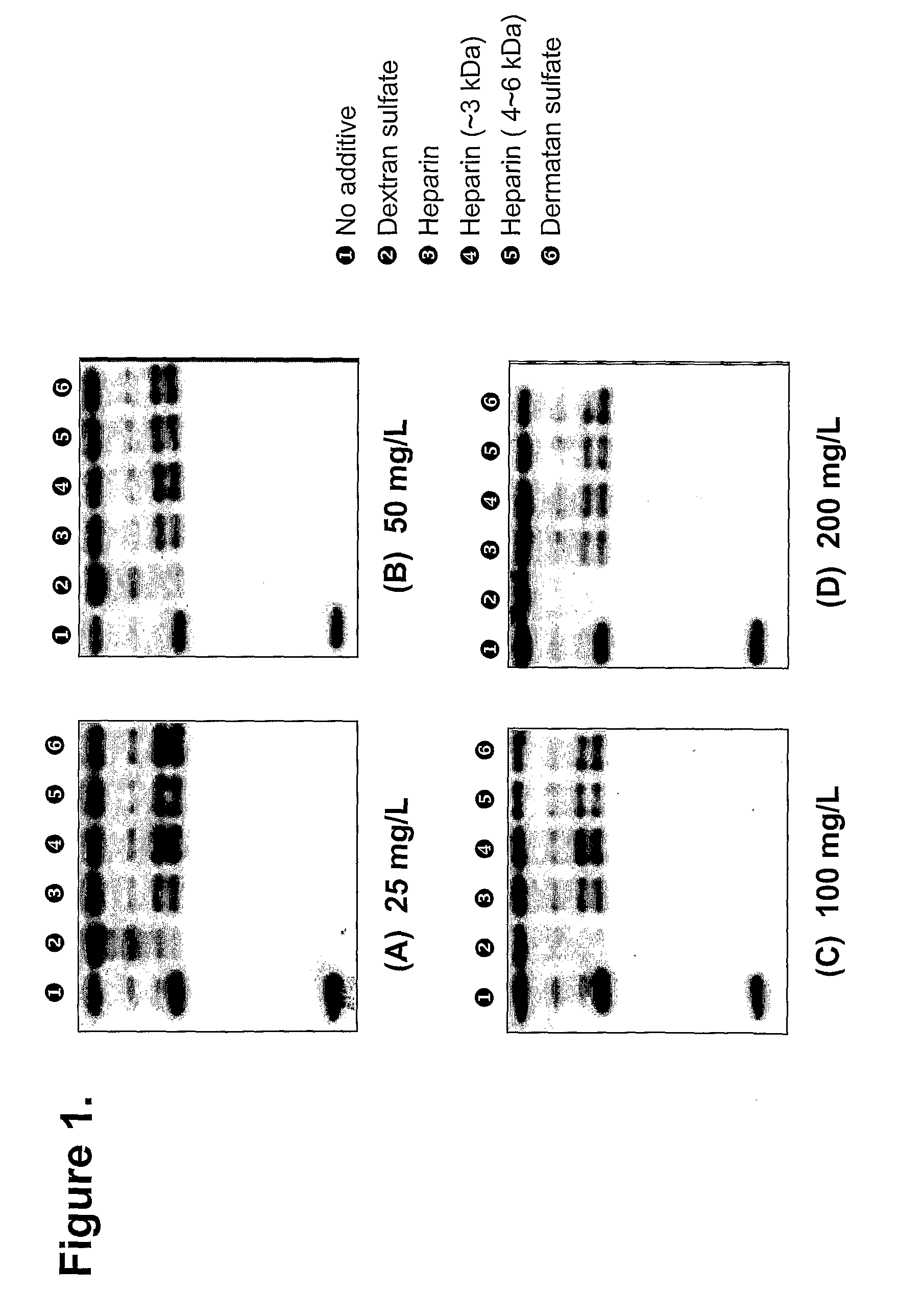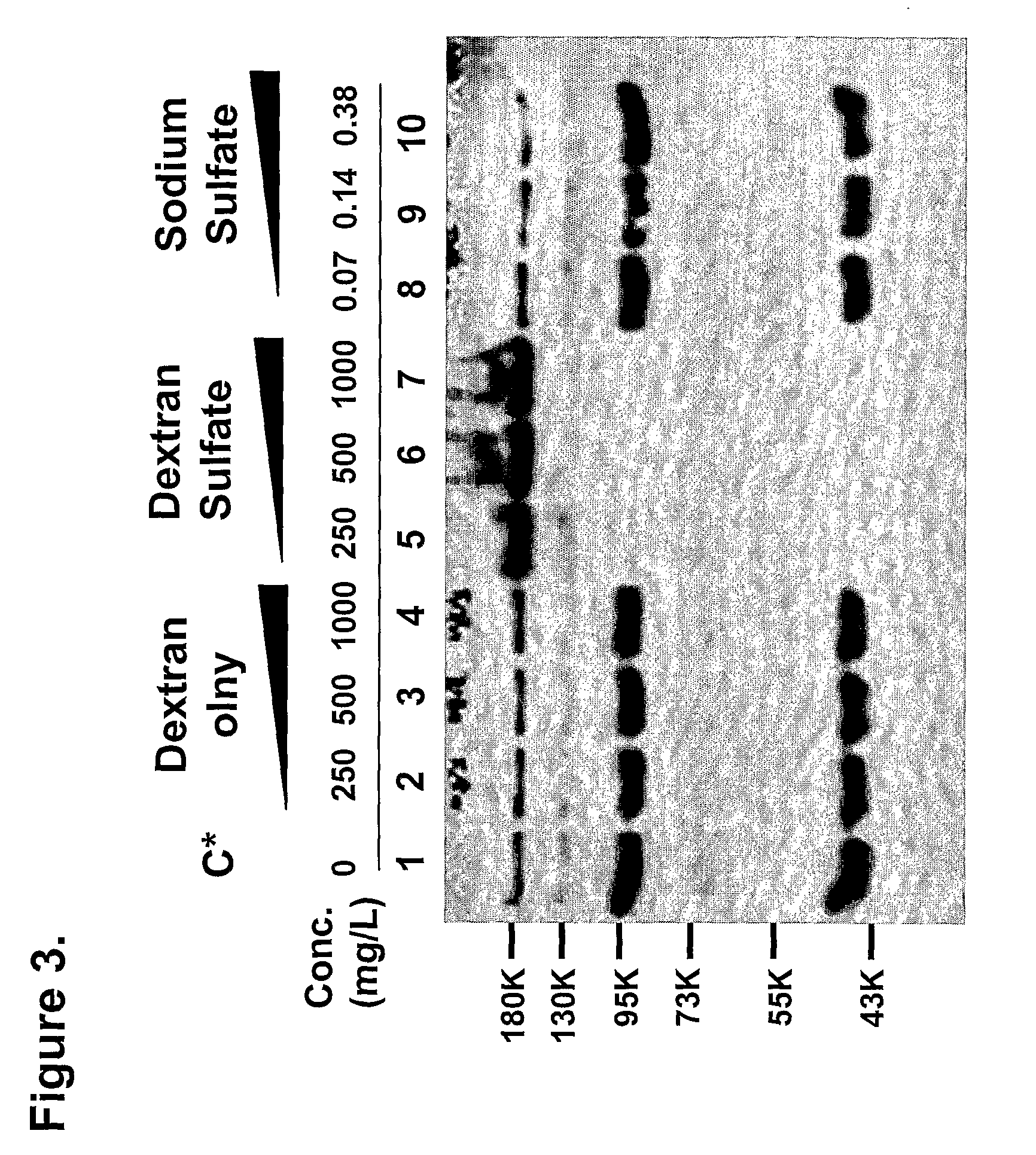Process for producing and purifying factor viii and its derivatives
a technology of factor vii which is applied in the field of process for producing and purifying factor viii and its derivatives, can solve the problems of difficult to maintain the viability of cells during the production process, difficult to maintain “lot to lot” consistency, and the recombinant factor viii production has not met its demand, so as to reduce or block the activity of factor viii-cleaving, increase the homogenity of the produced factor viii derivative, and increase the homogenity of the produced factor
- Summary
- Abstract
- Description
- Claims
- Application Information
AI Technical Summary
Benefits of technology
Problems solved by technology
Method used
Image
Examples
example 2
Effect of Molecular Weight of Dextran Sulfate on Cleavage of I2GdBN
[0029]If dextran sulfate with a lower molecular weight can be applied to protect the cleavage, a lower molecular weight of dextran sulfate may be easily separated from factor VIII more based on its difference in size. So, to see if lower molecular weight of dextran sulfate can protect the cleavage of expressed I2GdBN during cell cultivation, 8 kDa, 10 kDa and 500 kDa dextran sulfate, which have the same content of sulfur and originated from the same source, were added to the medium at varying concentrations of 100 mg / L, 200 mg / L, 400 mg / L and 1000 mg / L. At 72 hours after addition of dextran sulfate, culture medium was harvested and analyzed by Western blotting assay. As shown in FIG. 2, although an increasing amount of dextran sulfate with low molecular weight (lane 1 to lane 8 in FIG. 2) was added into the cell culture medium, there was not observed any efficient protective effect on I2GdBN cleavage. Only 500 kDa de...
example 3
Only Sulfated Dextran can Protect the Cleavage
[0030]To see if a separate functional group of dextran sulfate has the inhibitory effect of cleavage, equimolar amounts of dextran (500 kDa), sodium sulfate, and dextran sulfate (500 kDa) were added in the culture medium. Cells were seeded as described in experiments. At 24 hours after seeding, several concentrations ranging from 250 mg / L to 1000 mg / L of dextran sulfate (500 kDa) and dextran (500 kDa) or several concentrations ranging from 71 g / L to 384 g / L of sodium sulfate were added to the medium. At 48 hours after addition, medium was collected from each well and analyzed by Western blot assay. As shown in FIG. 3, only 500 kDa dextran sulfate (lane 5 to lane 7) showed protective effect on cleavage of I2GdBN as depicted in FIG. 3. Neither dextran only (lane 2 to lane 4) nor sodium sulfate (lane 8 to lane 10) was shown to inhibit the protease activities of released protease(s) during CHO cultivation. Fragmentation pattern of culture me...
example 4
Application of Dextran Sulfate to Suspension Culture
[0031]Dextran sulfate (500 kDa) was applied to a perfusion culture system. One vial of cell was thawed and expanded in T75 flask and further expanded in 1125 flask. Cells in T125 flask were transferred into 250 ml, 1 L and 3 L spinner flasks serially and maintained as suspension culture on a magnetic stirrer plate at 37° C. in 5% of CO2 / air mixture with a rotation speed of 100 rpm. Exponentially growing cells in 3 L spinner flask were collected and inoculated into 7.5 L bioreactor with a working volume of 5 L. Dextran sulfate (500 kDa) was added at the concentration of 200 mg / L in the serum free medium in the bioreactor. From the fourth day after inoculation, the culture medium was collected every second day for 20 days. Cell viability was maintained above 92.7% during culture perfusion, and factor VIII fragment was detected less than 5% judged by densitometric analysis of each band in Western blot during fermentation process. Exem...
PUM
| Property | Measurement | Unit |
|---|---|---|
| average molecular weight | aaaaa | aaaaa |
| molecular weight | aaaaa | aaaaa |
| molecular weight | aaaaa | aaaaa |
Abstract
Description
Claims
Application Information
 Login to View More
Login to View More - R&D
- Intellectual Property
- Life Sciences
- Materials
- Tech Scout
- Unparalleled Data Quality
- Higher Quality Content
- 60% Fewer Hallucinations
Browse by: Latest US Patents, China's latest patents, Technical Efficacy Thesaurus, Application Domain, Technology Topic, Popular Technical Reports.
© 2025 PatSnap. All rights reserved.Legal|Privacy policy|Modern Slavery Act Transparency Statement|Sitemap|About US| Contact US: help@patsnap.com



